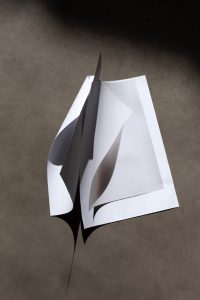When Lorena van Bunningen, 2020 winner of the Piket Art Prizes in the Painting category, was interviewed about the impact of the Covid-19 measures in August of last year it was clear she also saw the positive side of cancellations and withdrawals. Her side job at the Rotterdam Wereldmuseum was suspended and her social life faded away, but this gave her peace and focus. “Making art can be a very abstract thing,“ Lorena says.
“And sometimes you feel an enormous need for concrete events that provide distraction, like drinking coffee with friends. But that became impossible. What is essential, remained and that was really good. I was immensely creative. But now I long to get out of the rut. Nothing happens. As far as I’m concerned, it’s time to get things going again.” On the other hand she finds that the idea of ‘back to normal’ leads to a new kind of pressure. “There is this sense of ‘I should take the opportunity to make things, now that I still have lots of time’.” Nevertheless, she is looking forward to the Wereldmuseum reopening by the end of April so that she can take up her side job again.
Using film as photography
Lorena, who was born in Ecuador, hopes to be able to travel again this year. She misses her mother who still lives there and whom she hasn’t seen for almost two years. And she’s just a little homesick for South-America. “South-Americans are much more physical, much more reach-out-and-touch than Dutch people. I really miss that.” In the earlier interview Lorena mentioned the invitation to take part in two group exhibitions which are scheduled to take place this summer in Quito and Puyo under the title SAMAY. So far she hasn’t heard they have been cancelled. “Three and a half weeks in Ecuador! I greatly look forward to it.”
Lorena’s contribution will be the film she made when she and her mother visited the Amazon region in 2019. “I wanted to do something with film and motion, because photography is always rather static,” she explains. “For this project I used film as I would use photography. It’s not a video work with a clear beginning and ending. You could see it as a photographic work with motion. The film focuses on women working in the fields. The way they bend their backs while working almost becomes a kind of sculpture, because they spend so many hours of their lives in this attitude. I wanted to capture the monumental, sculptural feel of it. Actually, my work straddles photography and sculpture. Photography really is my thing.”
Print&Play
During the past few months, Lorena has been working on a new object for Print&Play. “A whole group of artists is creating new work especially for this new edition of Print&Play,” she explains. “The idea is that every work can be put together by the viewers themselves. Everyone can download a PDF from the website. There are lots of interactive and playful elements in every work, especially in the one I developed. It’s very interesting all, because you directly involve the viewer in the work. The viewer hangs the works in his or her own home, according to their own ideas and preferences. In this way, in the context of this exhibition, the viewer not only becomes a kind of maker, but also a curator. What is interesting and fun, too, is that there will be a hundred different exhibitions, in different spaces, but all with the same works.” The exhibition will be launched in May. “Actually, my work sells well,” Lorena says. “It’s clear that people have money and want to spend it on art, supporting young artists in the process. Normally they would spend it on a journey, but now there’s room for acquiring this work of art they had always been looking for. I get very positive response via Instagram, also from abroad.”
Print of an A4, rolled up A4, shadow (Print&Play).
At present, Lorena sells her work via online gallery Patty Morgan, amongst others, but she intends to look for a gallery in the near future. “A gallery owner has the network and expertise to provide real exposure. An artist’s network is usually more limited, and besides, you’re good at creating work, not at selling it.” In addition there is MALO, the studio for product photography where Lorena collaborates with fellow artist and friend Majda Vidakovic. “We’re both autonomous artists. During the creative process it may take some time before it becomes clear what the final result is going to be. Sometimes it all remains just an experiment. What we like about studio MALO is working towards a specific aim, within a clear framework and with a deadline. And it’s wonderful to collaborate with others. You can really learn from each other. It’s so different from working on your own.‘’
Examples of work: Attempts to sculpt a Movement en Tree
Buying time
Thanks to the Piket Art Prize Lorena was able to buy a new laptop. “All set for the next ten years,” she happily states. “I do not spend much on materials because I mostly work with found objects, but thanks to the prize I’m also able to afford my trip to South-America.” The most important aspect of the prize remains the fact that it allows her to, as it were, ‘buy time’. “The artist’s life is insecure and some people find this hard to deal with. In the end, they settle for security, and I can understand that. I think I can cope with insecurity and am not afraid of it, but still, something like my Mondriaan Fund grant or winning the Piket Art Prize – it truly makes a difference. It provides me with freedom and possibilities.”
Text: Anna Beerens
Photo: Hessel Waalewijn





